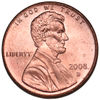Penny
 From Conservapedia - Reading time: 3 min
From Conservapedia - Reading time: 3 min
A penny is a type of small coin, and is usually the smallest denomination of a currency. Some countries including Canada,[1] Australia and Sweden have discontinued the penny coin[2] while the U.S. continues to mint them, at a financial loss.[3][4]
United States[edit]
The penny is a coin worth one cent. It was made primarily of copper until 1982, and is now made primarily of zinc. In 1943, pennies were made of steel, since copper was needed for the war. The US penny, as of 1960, features Abraham Lincoln on the obverse side, and the Lincoln Memorial on the reverse. From 1909 to 1959, the penny featured two stalks of wheat, thus it being dubbed a 'wheat penny'. The penny is copper-colored, and is one of the few coins that is not silver-colored. It is also smooth along the circumference of the coin, lacking the ridges that many other coins have.
The obverse (face) side of U.S. Pennies also have the date of creation stamped on the right side of Lincoln. Below this, they show either a "D" or a "P" to show that the coin was minted in either Denver, Colorado, or Philadelphia, Pennsylvania. Also stamped on the coin is the phrase "In God We Trust," although there has been a push to have this removed for U.S. coinage.
To celebrate the bicentennial of Abraham Lincoln's birth in 2009, the U.S. Mint released four new pennies depicting the life of the nation's sixteenth president. The pennies "show Lincoln's Kentucky birthplace, his Indiana education, his career as an Illinois statesman and his work in Washington, D.C." [5]
Great Britain[edit]
The penny first appeared in Anglo-Saxon England in the late seventh century. Pennies were originally made of silver, subsequently copper and later bronze, since 1992 they have been made of copper-plated steel.
The plural is pence when referring to an amount of money, or pennies when referring to the coins. Pre-decimalisation there were 12 pence (written as 12d) to the shilling (written as 1s) and 20s to the pound, giving 240 pence to the pound. Post-decimalisation this was changed to 100 new pence in the pound, making one new penny equal to 2.4 old pence, five new pence equal to the shilling and ten new pence equal to two shillings.
The penny was not the smallest unit of currency. Until 1960, this title was held by the farthing (one quarter of a penny). After 1960, the smallest unit was the halfpenny (known as the ha'penny, pronounced haip-nee). After decimalisation, a half-penny coin was circulated until 1984.
Australia[edit]
Before Australia adopted decimal currency in 1966, the penny was the second-smallest denomination (the smallest being the halfpenny). When the cent replaced the penny in 1966, it was worth a bit more (ten cents were worth twelve pennies), and the term "penny" fell out of use.
References[edit]
- ↑ https://www.huffingtonpost.com/2013/02/04/canadian-penny-discontinued_n_2615919.html
- ↑ http://www.history.com/news/10-things-you-didnt-know-about-the-penny
- ↑ https://blogs.wsj.com/economics/2014/12/15/just-how-much-does-it-cost-to-make-a-penny
- ↑ http://usatoday30.usatoday.com/money/2006-05-09-penny-usat_x.htm
- ↑ U.S. Mint Releases New Penny Designs, Sara Bonisteel, Fox News, September 22, 2008
 KSF
KSF




